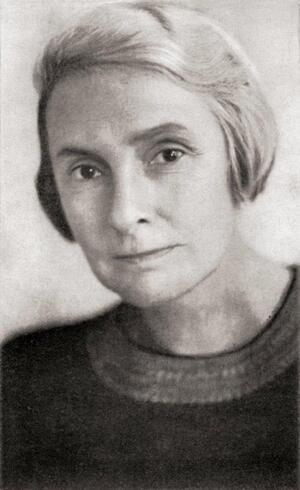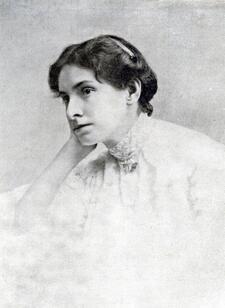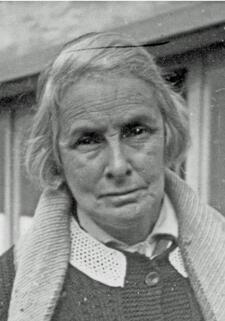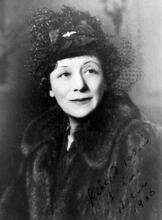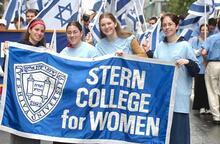Jessie Ethel Sampter
Jessie Sampter was a writer, thinker, and Zionist educator. She wrote in English and Hebrew about Jewish nationalism, Arab-Jewish relations, life in the Yishuv, and her own experiences. Born into an Ethical Culture household, Sampter turned to Judaism and Zionism as a young adult. In 1919, after several years of leadership within Hadassah, she moved from her native New York to Palestine. Once there, she established close relationships with other Zionists, including Leah Berlin; Berlin would live with Sampter for much of the rest of their lives. In 1934, they moved to Kibbutz Givat Brenner, where Sampter brought funds to establish a vegetarian rest home for workers. Although Sampter’s disability and non-normative family structure did not align with Zionist ideals of strong, healthy bodies, she championed Zionism, though not always uncritically.
Early Life
Jessie Sampter was born on March 22, 1883, in New York to attorney Rudolph Sampter and Virginia Kohlberg Sampter, well-off second-generation German-American Jews. Although both her parents were raised Jewish, Jessie and her older sister Elvie grew up in an Ethical Culture household, which included Christmas trees, Jewish and Christian visitors, and books from a variety of religious traditions.
Sampter’s parents valued education, so when they deemed her to be a frail and sickly child, they hired tutors to come to the house. Later, she audited courses at Columbia University. Throughout her life, she was an ardent student, including learning Hebrew as an adult.
When Rudolph died of tuberculosis in 1895 at age 44, Sampter was crushed. He had nurtured her love of reading, offered her help with her poetry, and encouraged her philosophical curiosity. As Sampter later wrote in an autobiographical novel, she “loved him just a little bit more, because he understood” (quoted in Badt-Strauss). A year later, Sampter contracted polio, which left her hands and back “deformed,” as she wrote, and caused her continued pain and exhaustion for the rest of her life.
Writing and Commitment to Education
Sampter began her writing career even before adulthood. She published poetry in St. Nicholas, a magazine for children; it impressed the editor so much that he paid her a visit. Through Israel Zangwill she met Mary Antin; the two bonded over being young writers and became lifelong friends.
Her first book, The Great Adventurer (1909), subtly drew on Hinduism and transcendentalism to articulate her view of God and the cosmos. In 1910, Sampter published The Seekers, a book that detailed her experiences organizing a discussion group for six teenagers to explore religious and philosophical ideas. The Harvard philosopher Josiah Royce wrote a forward to the book, calling it “a successful experiment in non-sectarian religion, in moral and aesthetic enquiry, with young people in new ways, in search of the Meaning of Things.” The book prioritized inquiry rather than doctrine, and Sampter capitalized on the possibilities created by the teenagers’ diverse religious backgrounds.
Sampter continued her interest in educating children throughout her life, often writing for the Zionist journal Young Judaean, publishing her own poem collection Around the Year in Rhymes for the Jewish Child in 1920, and translating into English Hayim Bialik’s poems in Far Over the Sea: Poems and Jingles for Children just before her death.
Sampter also advocated for education in the Jewish community in Palestine prior to the establishment of the State of Israel. "Old Yishuv" refers to the Jewish community prior to 1882; "New Yishuv" to that following 1882.Yishuv once she settled there. She participated in organizing and fundraising for what would become the first school for the Deaf in Palestine. She also worked to ensure that education was available for Yemenite Jews in the Yishuv. Noticing that Jews of European origin and their descendants, including most of North and South American Jewry.Ashkenazi families excluded Yemenite children from kindergartens and other schools, Sampter helped create a kindergarten for Yemenite children, a girl scout troop for Yemenite girls, and an evening class for Yemenite working girls.
Turn to Zionism
In the early 1910s, Sampter continued on her own path of religious and philosophical inquiry. She had been attending a Unitarian Church led by Merle St. Croix Wright, where she heard Hyman Segal read his Zionist poetry. Enthralled, she began to learn more about the Zionist movement in the United States. Sampter became close to Henrietta Szold, the founder of the women’s Zionist organization Hadassah, who mentored Sampter in her journey to Zionism and then to Judaism.
By 1914, Sampter had become a key figure in Hadassah. She served on the Central Committee, the organization’s main leadership council, alongside Szold, Lotta Levensohn, Nellie Straus Mochenson, Alice Seligsberg, and others. Together, the women were effective organizers and fundraisers, though they did experience friction with the male-run Zionist Organization of America. The ZOA tried to bring Hadassah under its own leadership structure, and often the men wanted the women’s support “but not their minds,” as Henrietta Szold wrote.
Sampter had no trouble using her mind for Hadassah, however. She helmed the organization’s education department, served as a consultant for Zionist education in Baltimore, and ultimately published A Course in Zionism (1915), which brought together her investment in education with her Zionism. She also published articles, pamphlets, and speeches in favor of Zionism. “Nationalism and Universal Brotherhood,” for example, argued for a principled position in favor of both internationalism and Zionism: “As a Jew I see that the idea of universal brotherhood is the crowning of Jewish prophecy. And yet the Jewish prophets were all nationalists.” She saw each nation (by which she meant something like people-group or culture, rather than nation-state) as contributing its own unique values and characteristics to the whole of humanity.
After the outbreak of World War I, male Zionist leaders insisted that that Sampter and her pacifist colleagues on Hadassah’s Central Committee resign from the pacifist organization People’s Council for Peace and Democracy because it was “anti-government.” Both she and Szold felt terribly conflicted; they were committed Zionists but could not see how such a commitment could require supporting war. Although the women capitulated and retained their positions within Hadassah, the issue of war continued to animate much of Sampter’s writing in those years. The prose-poetry Sefer ha-Goyim/ Book of Nations (1917) used biblical allusions to excoriate modern nations for their imperialism and economic sins that had led to the war. The Coming of Peace (1919), a poetry collection, included unambiguous statements such as “And nations shall liberate themselves with councils, Not others with the sword.” After the war’s end, she wrote: “I lost my country in the shame of victory” (Speaking Heart).
These years also marked a kind of unrest in Sampter: she ardently wanted to go to Palestine, and she was feeling less and less at home in the United States. She had been working for the ZOA to write a new edition of Course in Zionism, to be called A Guide to Zionism. Although Louis Brandeis expressed his reluctance, and the ZOA secretary initially refused her request, in 1919 Sampter packed “a trousseau” because it was “as if she was to be married” to Palestine, and left (Speaking Heart).
Move to Palestine
Sampter fell ill and was hospitalized upon her arrival in Jerusalem. Yet she did not see herself as a drain on the Zionist cause. Rather, her essays framed her experience as a celebration of Zionism for her English-speaking audiences: “To me it was almost worth the discomfort of a serious illness that I might spend several weeks as a patient, in the ranks of patients, in our own Hadassah Hospital in Jerusalem—the Rothschild Hospital” (“Bed Number Six”). Sampter did not always speak glowingly about all Zionist endeavors in the Yishuv, but she committed her time and limited energy to writing that she hoped would help create a Jewish society that made space for people beyond able-bodied Ashkenazi men.
Sampter spent the rest of her life in Palestine, apart from two trips back to the United States. Soon after her arrival, Sampter met Leah Berlin, a Russian Zionist, and the two decided to live together in Jerusalem. They lived apart for several years after Berlin’s family came to Palestine. During that time, Sampter adopted three-year-old Tamar, a Yemenite Jewish toddler, with whom she had developed a relationship during her visits to a Jerusalem orphanage. It was uncommon for single women to adopt children to whom they were not related, but Sampter’s interest in education meant she had long been around children. Jessie and Tamar moved into a house in Rehovot, but Sampter and Berlin always remained in very close contact.
During these years, Sampter continued to write for Hadassah, the ZOA, and other English-language periodicals. In 1927, she published The Emek, a collection of poems about the Jezreel Valley. She also began publishing in Hebrew, including poetry that appeared in the newspaper Davar.
Unlike many other American Zionists, Sampter explicitly discussed the relationship between Jews and Arabs in Palestine. She yearned for “brotherhood” between the two groups, and she blamed the British for stirring up animosity between them. In a very unusual move, Sampter applied and received her Palestinian passport in 1926 and she gave up her US citizenship. She wanted to make her commitment clear: this was her society, and she was invested in it.
Kibbutz Givat Brenner
In 1934, Sampter and Leah Berlin decided to become members of Kibbutz Givat Brenner. Members initially expressed ambivalence about them moving there, referring to the two women as “old” and wondering what use a disabled woman could be, apart from the money she would bring. Part of the issue was also that Sampter wanted the kibbutz to use some of her funds to build a vegetarian rest home where workers could recuperate, but individual members declaring how their money should be used went against its communal ethos of finances. After deliberation, the kibbutz members agreed, and the two women and Tamar joined. Sampter would write the kibbutz newsletter.
Sampter died on November 11, 1938, likely from complications from malaria. Szold presided over her funeral. The kibbutz renamed the rest home Bet Yesha in her honor.
Selected Works by Jessie Sampter
Around the Year in Rhymes for the Jewish Child. New York: Bloch Publishing, 1920.
“Bed Number Six.” Bnai Israel Bulletin [Pittsburgh] (1922): 12-13.
Coming of Peace. New York: Publishers Printing Company, 1919.
A Course in Zionism. New York: Federation of American Zionists, 1915.
The Emek. New York: Bloch, 1927.
Far Over the Sea: Poems and Jingles for Children. Cincinnati: Union of American Hebrew Congregations, 1939.
Great Adventurer. New York: Kerr Press, 1909.
Seekers. New York: Mitchell Kennerley, 1910.
Sefer ha-Goyim [Book of Nations]. New York: EP Dutton and Company, 1917.
“Speaking Heart” unpublished manuscript, Central Zionist Archives, Jerusalem.
Antler, Joyce. The Journey Home: Jewish Women and the American Century. New York: Simon and Schuster, 2010.
Badt-Strauss, Bertha. White Fire: The Life and Works of Jessie Sampter. Philadelphia: Reconstructionist Press, 1956.
Rebecca Boim Wolf. “Jessie Sampter’s School of Zionism.” In The Women Who Reconstructed American Jewish Education, 1910–1965, edited by. Carol K Ingall. Waltham, MA: Brandeis University Press, 2010
Chazan, Meir. “The Wise Woman of Givat Brenner.” In The Individual in History: Essays in Honor of Jehuda Reinharz, edited by ChaeRan Y. Freeze, Sylvia Fuks Fried, and Eugene R. Sheppard. Brandeis University Press, 2015.
Imhoff, Sarah. The Lives of Jessie Sampter: Queer, Disabled, Zionist. Durham, NC: Duke University Press, 2022.

